Investigation of Water and Heat Transfer Mechanism in PEMFCs Based on a Two-Phase Non-Isothermal Model
Abstract
1. Introduction
2. Model Development
2.1. Water Content
2.2. Water Saturation
2.3. Governing Equations
2.3.1. Dissolved Water Transport
2.3.2. Liquid Water Transport
2.3.3. Water Vapor Transport
2.3.4. Phase Change
2.3.5. Hydrogen Transport
2.3.6. Oxygen Transport
2.3.7. Electrochemical Model
2.3.8. Energy Conservation Model
2.4. Boundary Conditions and Computational Process
3. Results and Discussion
3.1. Model Validation
3.2. Sensitivity Analysis of Fuel Cell Operating Conditions
3.2.1. Effects of Output Voltage
3.2.2. Effects of Relative Humidity
3.2.3. Effects of Working Temperature
3.2.4. Effects of Different Inlet Gas Temperature
4. Conclusions
Author Contributions
Funding
Data Availability Statement
Conflicts of Interest
Abbreviations
| CL | catalyst layer |
| GDL | gas diffusion layer |
| AGDL | anode gas diffusion layer |
| ACL | anode catalyst layer |
| CGDL | cathode gas diffusion layer |
| CCL | cathode catalyst layer |
| PEM | proton exchange membrane |
| PEMFC | proton exchange membrane fuel cell |
| EW | equivalent weight |
| RH | relative humidity |
| HOR | hydrogen oxidation reaction |
| ORR | oxygen reduction reaction |
References
- Guo, J.Q.; He, H.W.; Li, J.W.; Liu, Q.W. Driving information process system-based real-time energy management for the fuel cell bus to minimize fuel cell engine aging and energy consumption. Energy 2022, 248, 123474. [Google Scholar]
- Kandidayeni, M.; Macias, A.; Boulon, L.; Kelouwani, S. Investigating the impact of ageing and thermal management of a fuel cell system on energy management strategies. Appl. Energy 2020, 274, 115293. [Google Scholar] [CrossRef]
- Tang, X.W.; Guo, Q.; Li, M.; Wei, C.H.; Pan, Z.Y.; Wang, Y.Q. Performance analysis on liquid-cooled battery thermal management for electric vehicles based on machine learning. J. Power Sources 2021, 494, 229727. [Google Scholar] [CrossRef]
- Gong, D.P.; Xu, S.C.; Wang, X.H.; Gao, Y. Numerical Study on the Effects of Water and Heat Transport on Two-Phase Flow in a Polymer Electrolyte Membrane Fuel Cell. Energies 2022, 15, 8318. [Google Scholar] [CrossRef]
- Alaswad, A.; Palumbo, A.; Dassisti, M.; Olabi, A.G. Fuel Cell Technologies, Applications, and State of the Art. A Reference Guide; Reference Module in Materials Science and Materials Engineering; Elsevier: Amsterdam, The Netherlands, 2016. [Google Scholar]
- Liso, V.; Araya, S.S.; Olesen, A.C.; Nielsen, M.P.; Kær, S.K. Modeling and experimental validation of water mass balance in a PEM fuel cell stack. Int. J. Hydrog. Energy 2016, 41, 3079–3092. [Google Scholar] [CrossRef]
- Liu, H.; Chen, J.; Hissel, D.; Lu, J.G.; Hou, M.; Shao, Z.G. Prognostics methods and degradation indexes of proton exchange membrane fuel cells: A review. Renew. Sustain. Energy Rev. 2020, 123, 109721. [Google Scholar] [CrossRef]
- Nolan, J.; Kolodziej, J. Modeling of an automotive fuel cell thermal system. J. Power Sources 2010, 195, 4743–4752. [Google Scholar] [CrossRef]
- Han, J.; Park, J.; Yu, S. Control strategy of cooling system for the optimization of parasitic power of automotive fuel cell system. Int. J. Hydrog. Energy 2015, 40, 13549–13557. [Google Scholar] [CrossRef]
- Pan, Y.W.; Wang, H.Z.; Brandon, N.P. A fast two-phase non-isothermal reduced-order model for accelerating PEM fuel cell design development. Int. J. Hydrog. Energ. 2022, 47, 38774–38792. [Google Scholar] [CrossRef]
- Gong, D.; Xu, S.; Zhang, B. Control Strategies for Prevention of PEMFC Oxygen Starvation: A Review; SAE WCX Digital Summit; SAE Technical Paper 2021-01-0743; SAE International: Warrendale, PA, USA, 2021; p. 1e17. [Google Scholar]
- Sinha, P.K.; Wang, C.-Y. Two-phase modeling of gas purge in a polymer electrolyte fuel cell. J. Power Sources 2008, 183, 609–618. [Google Scholar] [CrossRef]
- Jiang, F.M.; Wang, C.-Y. Numerical modeling of liquid water motion in a polymer electrolyte fuel cell. Int. J. Hydrog. Energy 2014, 39, 942–950. [Google Scholar] [CrossRef]
- Takalloo, P.K.; Nia, E.S.; Ghazikhani, M. Numerical and experimental investigation on effects of inlet humidity and fuel flow rate and oxidant on the performance on polymer fuel cell. Energy Convers. Manag. 2016, 114, 290–302. [Google Scholar] [CrossRef]
- Zhang, Z.Q.; Liu, W.; Wang, Y.L. Three dimensional two-phase and non-isothermal numerical simulation of multi-channels PEMFC. Int. J. Hydrog. Energy 2019, 44, 379–388. [Google Scholar] [CrossRef]
- Mu, Y.T.; He, P.; Bai, F.; Chen, L.; Qu, Z.-G.; Tao, W.-Q. Numerical analyses on oxygen transport resistances in polymer electrolyte membrane fuel cells using a novel agglomerate model. Int. J. Hydrog. Energy 2022, in press. [Google Scholar] [CrossRef]
- Rakhshanpouri, S.; Rowshanzamir, S. Water transport through a PEM (proton exchange membrane) fuel cell in a seven-layer model. Energy 2013, 50, 220–231. [Google Scholar] [CrossRef]
- Hu, J.M.; Li, J.Q.; Xu, L.F.; Huang, F.S.; Ouyang, M.G. Analytical calculation and evaluation of water transport through a proton exchange membrane fuel cell based on a one-dimensional model. Energy 2016, 111, 869–883. [Google Scholar] [CrossRef]
- Nalbant, Y.; Colpan, C.O.; Devrim, Y. Development of a one-dimensional and semi-empirical model for a high temperature proton exchange membrane fuel cell. Int. J. Hydrog. Energy 2018, 43, 5939–5950. [Google Scholar] [CrossRef]
- Jiang, Y.; Yang, Z.R.; Jiao, K.; Du, Q. Sensitivity analysis of uncertain parameters based on an improved proton exchange membrane fuel cell analytical model. Energy Convers. Manag. 2018, 164, 639–654. [Google Scholar] [CrossRef]
- Kusoglu, A.; Weber, A.Z. New insights into perfluorinated sulfonic-acid ionomers. Chem. Rev. 2017, 117, 987–1104. [Google Scholar] [CrossRef]
- Springer, T.E.; Zawodzinski, T.; Gottesfeld, S. Polymer electrolyte fuel cell model. J. Electrochem. Soc. 1991, 138, 2334. [Google Scholar] [CrossRef]
- Jiao, K.; Li, X. Water transport in polymer electrolyte membrane fuel cells. Prog. Energy Combust. Sci. 2011, 37, 221–291. [Google Scholar] [CrossRef]
- Nguyen, T.V.; Lin, G.; Ohn, H.; Wang, X. Measurement of capillary pressure property of gas diffusion media used in proton exchange membrane fuel cells. Electrochem. Solid-State Lett. 2008, 11, B127–B131. [Google Scholar] [CrossRef]
- Zawodzinski, T.A.; Derouin, C.; Radzinski, S.; Sherman, R.J.; Smith, V.T.; Springer, T.E.; Gottesfeld, S. Water-Uptake by and Transport through Nafion(R) 117 Membranes. J. Electrochem. Soc. 1993, 140, 1041–1047. [Google Scholar] [CrossRef]
- Ijaodola, O.S.; El-Hassan, Z.; Ogungbemi, E.; Khatib, F.N.; Wilberforce, T.; Thompson, J.; Olabi, A.G. Energy efficiency improvements by investigating the water flooding management on proton exchange membrane fuel cell (PEMFC). Energy 2019, 179, 246–267. [Google Scholar] [CrossRef]
- Weber, A.Z.; Borup, R.L.; Darling, R.M.; Das, P.K.; Dursch, T.J.; Gu, W.B.; Harvey, D.; Kusoglu, A.; Litster, S.; Mench, M.M.; et al. A Critical Review of Modeling Transport Phenomena in Polymer-Electrolyte Fuel Cells. J. Electrochem. Soc. 2014, 161, F1254–F1299. [Google Scholar] [CrossRef]
- Anders, C.O.; Torsten, B.; Kær, S.K. On the diffusion coefficient of water in polymer electrolyte membranes. ECS Trans. 2013, 50, 979. [Google Scholar]
- Ge, S.H.; Li, X.G.; Yi, B.L.; Hsing, I.M. Absorption, desorption, and transport of water in polymer electrolyte membranes for fuel cells. J. Electrochem. Soc. 2005, 152, A1149–A1157. [Google Scholar] [CrossRef]
- Jiao, K.; Li, X.G. Effects of various operating and initial conditions on cold start performance of polymer electrolyte membrane fuel cells. Int. J. Hydrog. Energy 2009, 34, 8171–8184. [Google Scholar] [CrossRef]
- Jiao, K.; Li, X.G. Three-dimensional multiphase modeling of cold start processes in polymer electrolyte membrane fuel cells. Electrochim. Acta 2009, 54, 6876–6891. [Google Scholar] [CrossRef]
- Guo, Q.; Luo, Y.Q.; Jiao, K. Modeling of assisted cold start processes with anode catalytic hydrogen-oxygen reaction in proton exchange membrane fuel cell. Int. J. Hydrog. Energy 2013, 38, 1004–1015. [Google Scholar] [CrossRef]
- Ozen, D.N.; Timurkutluk, B.; Altinisik, K. Effects of operation temperature and reactant gas humidity levels on performance of PEM fuel cells. Renew. Sustain. Energy Rev. 2016, 59, 1298–1306. [Google Scholar] [CrossRef]
- Pasaogullari, U.; Wang, C. Liquid water transport in gas diffusion layer of polymer electrolyte fuel cells. J. Electrochem. Soc. 2004, 151, A399. [Google Scholar] [CrossRef]

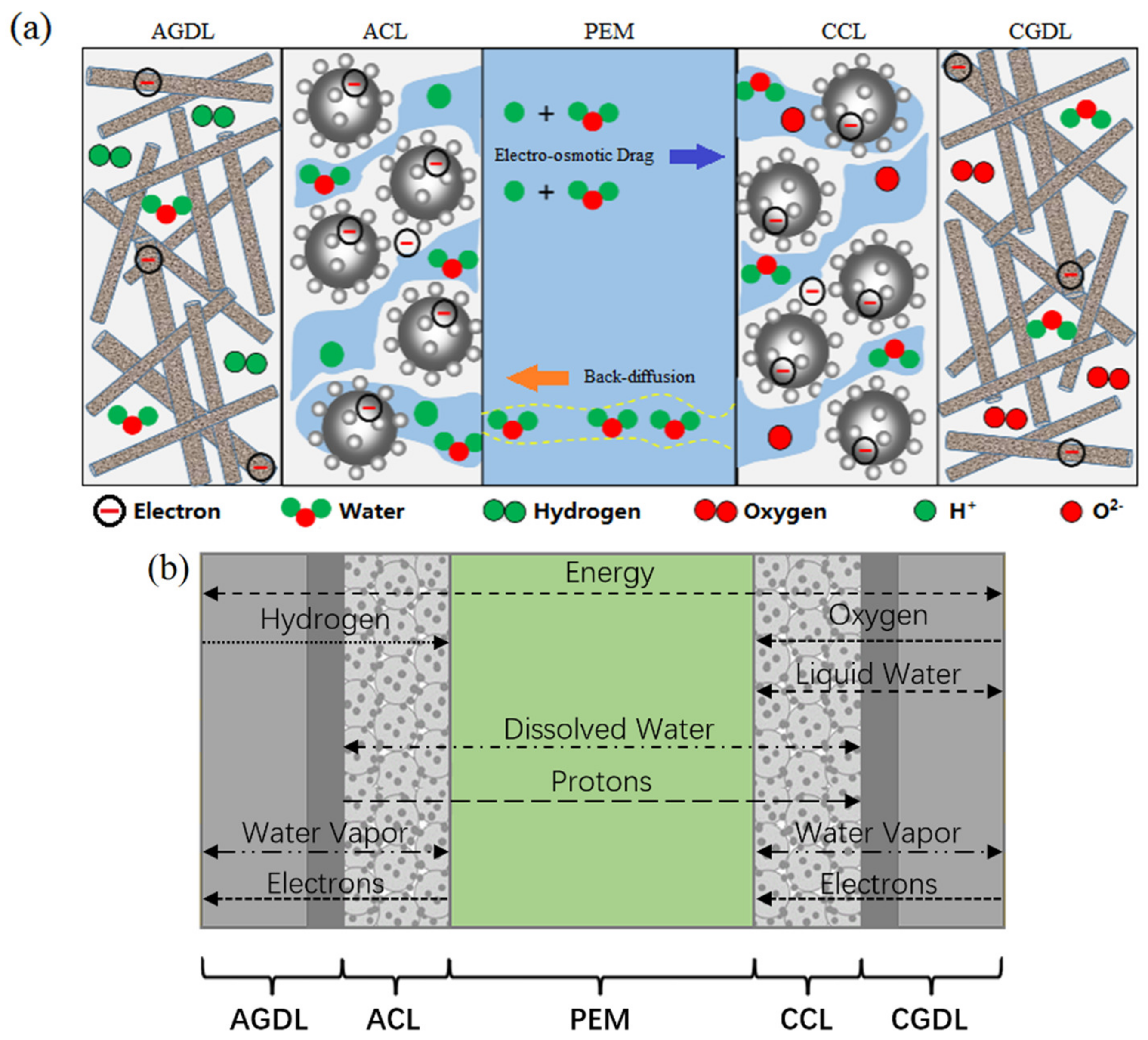
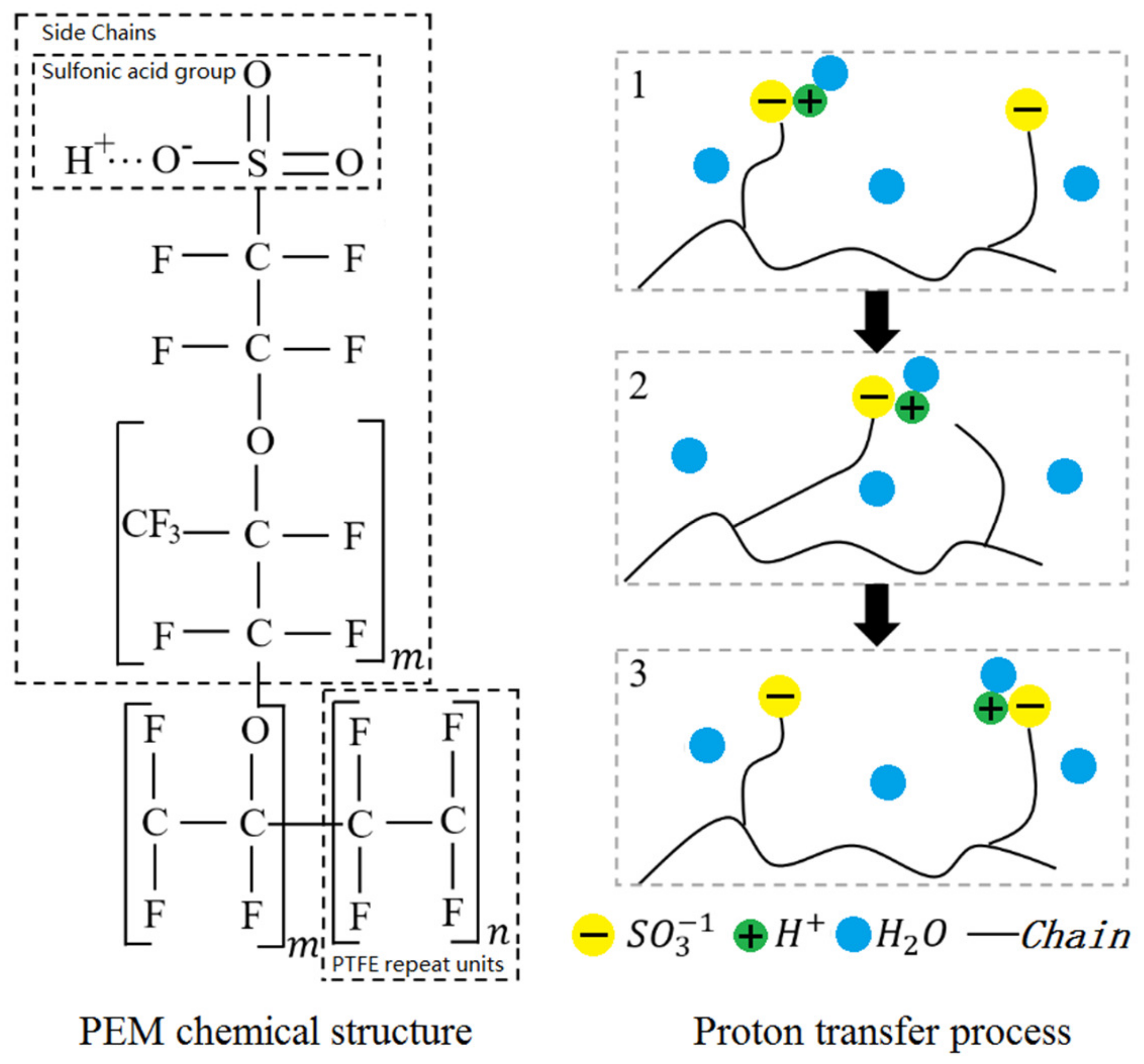
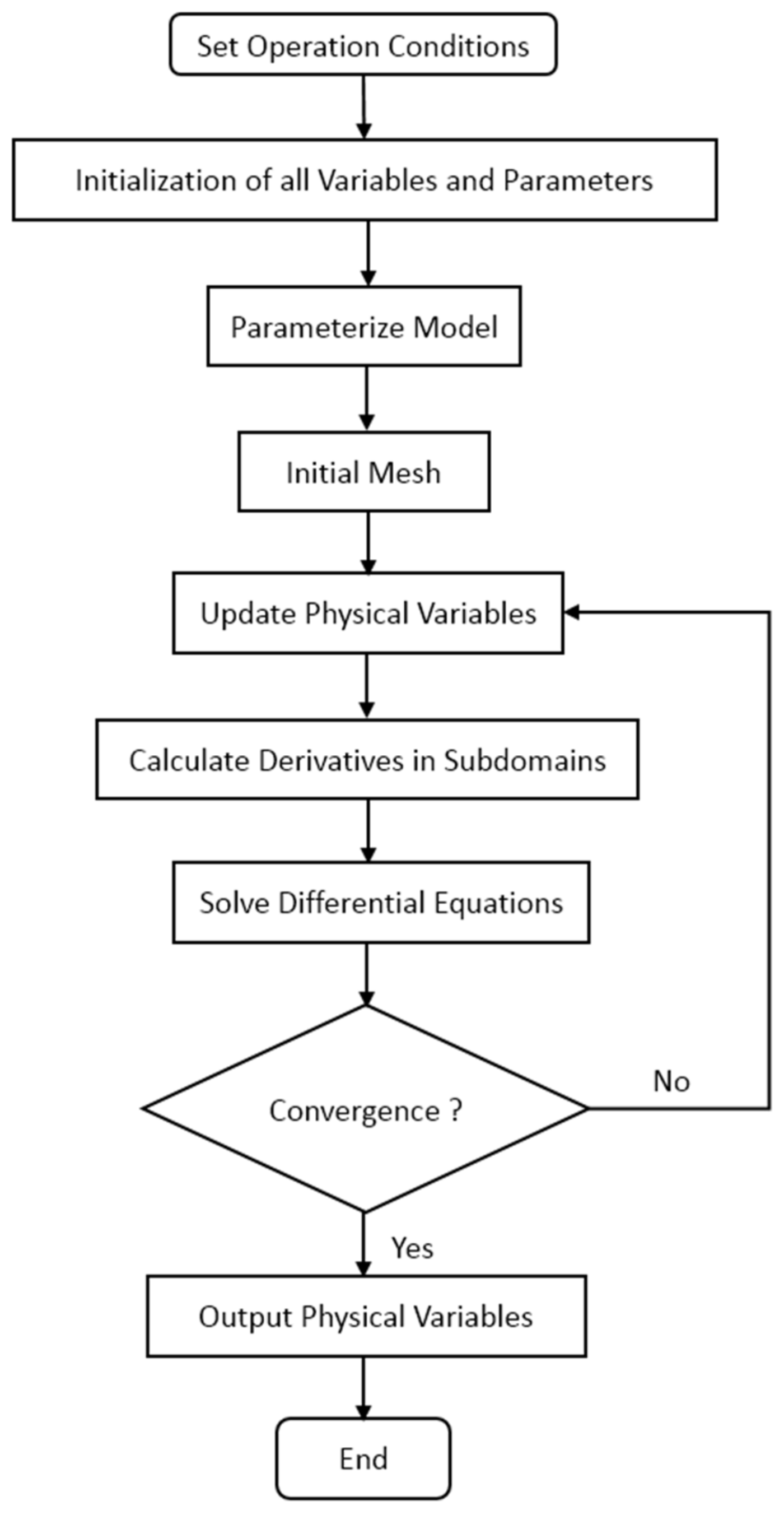
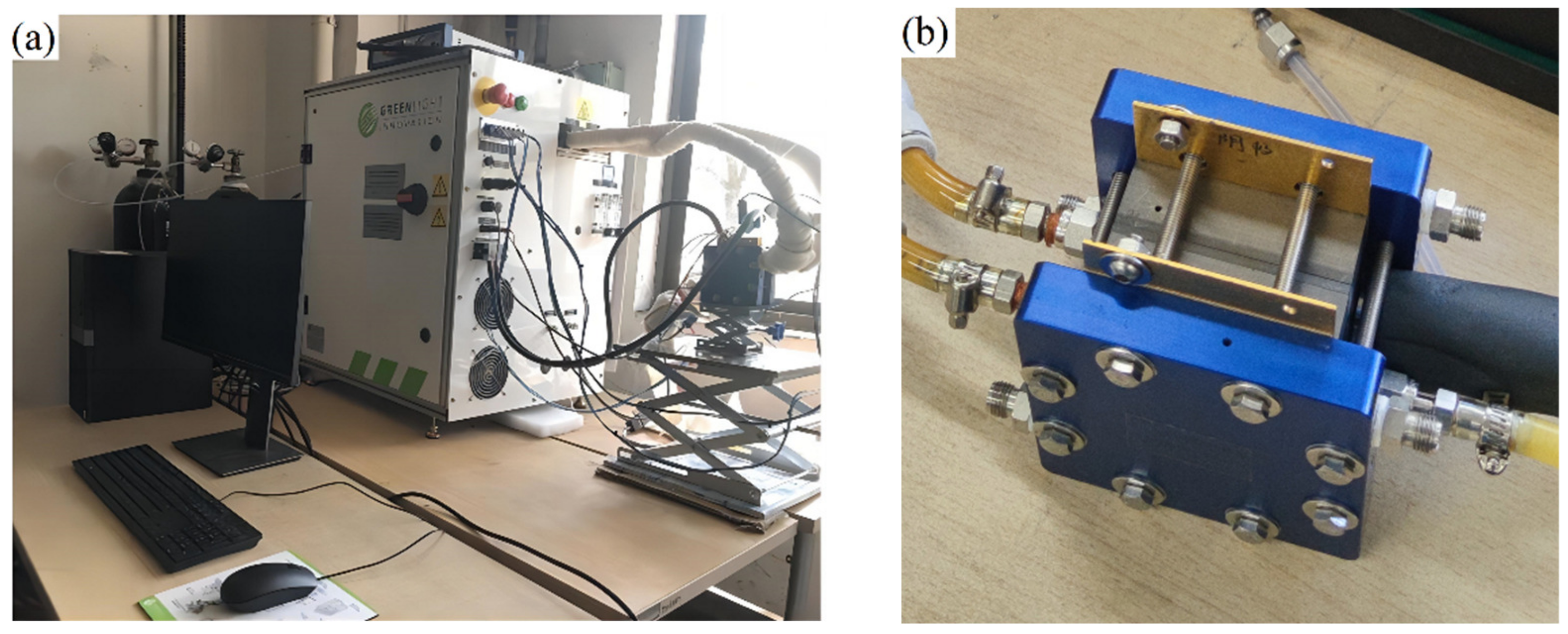
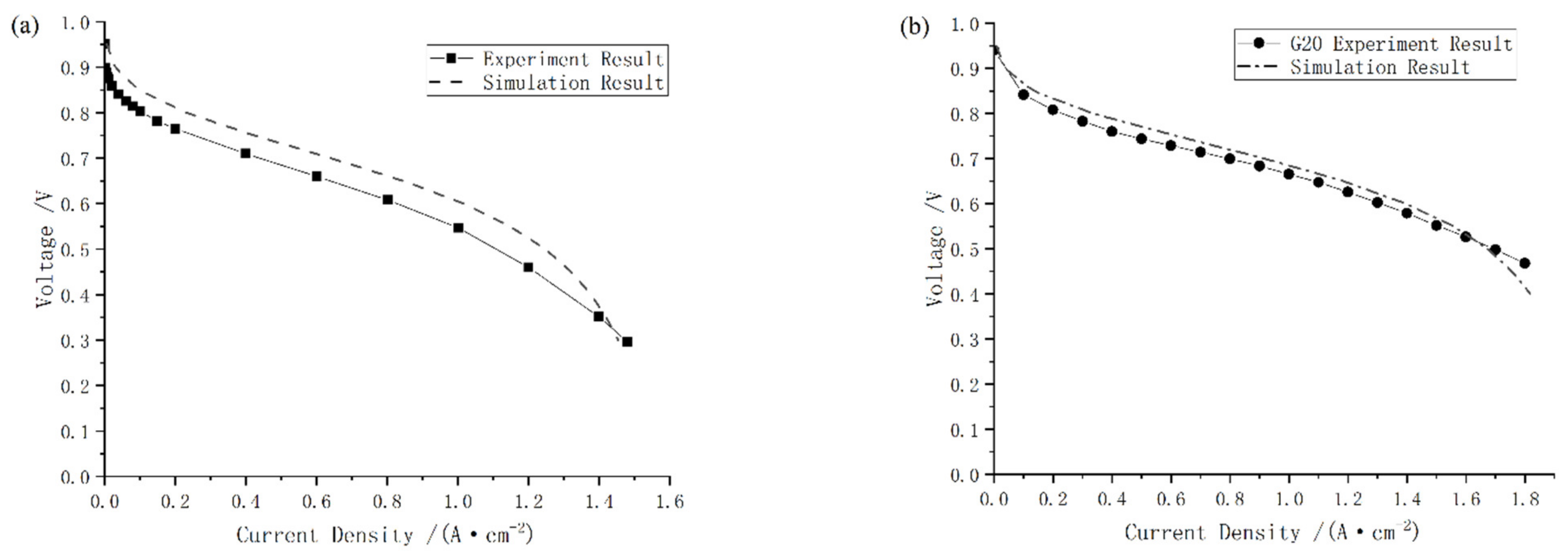

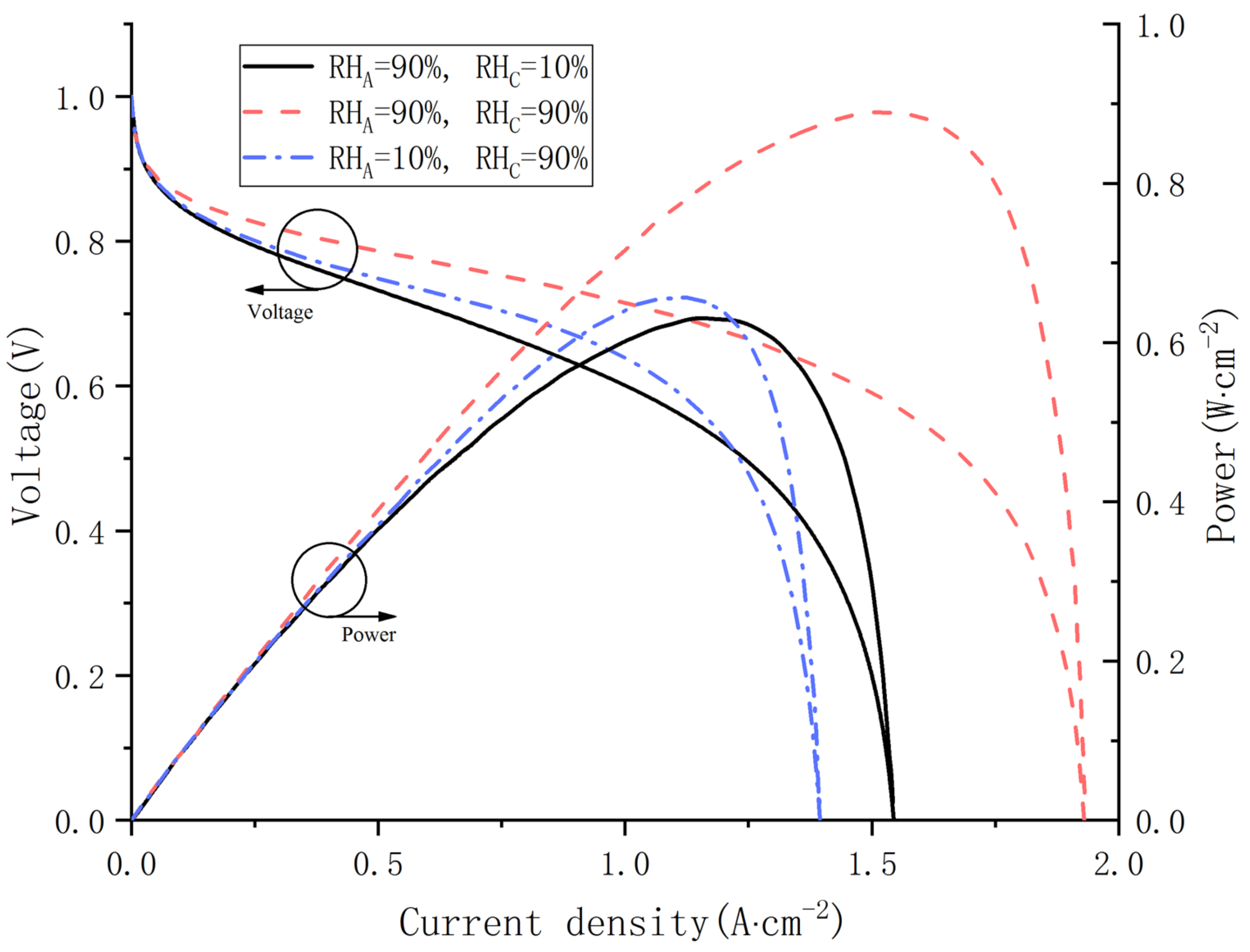

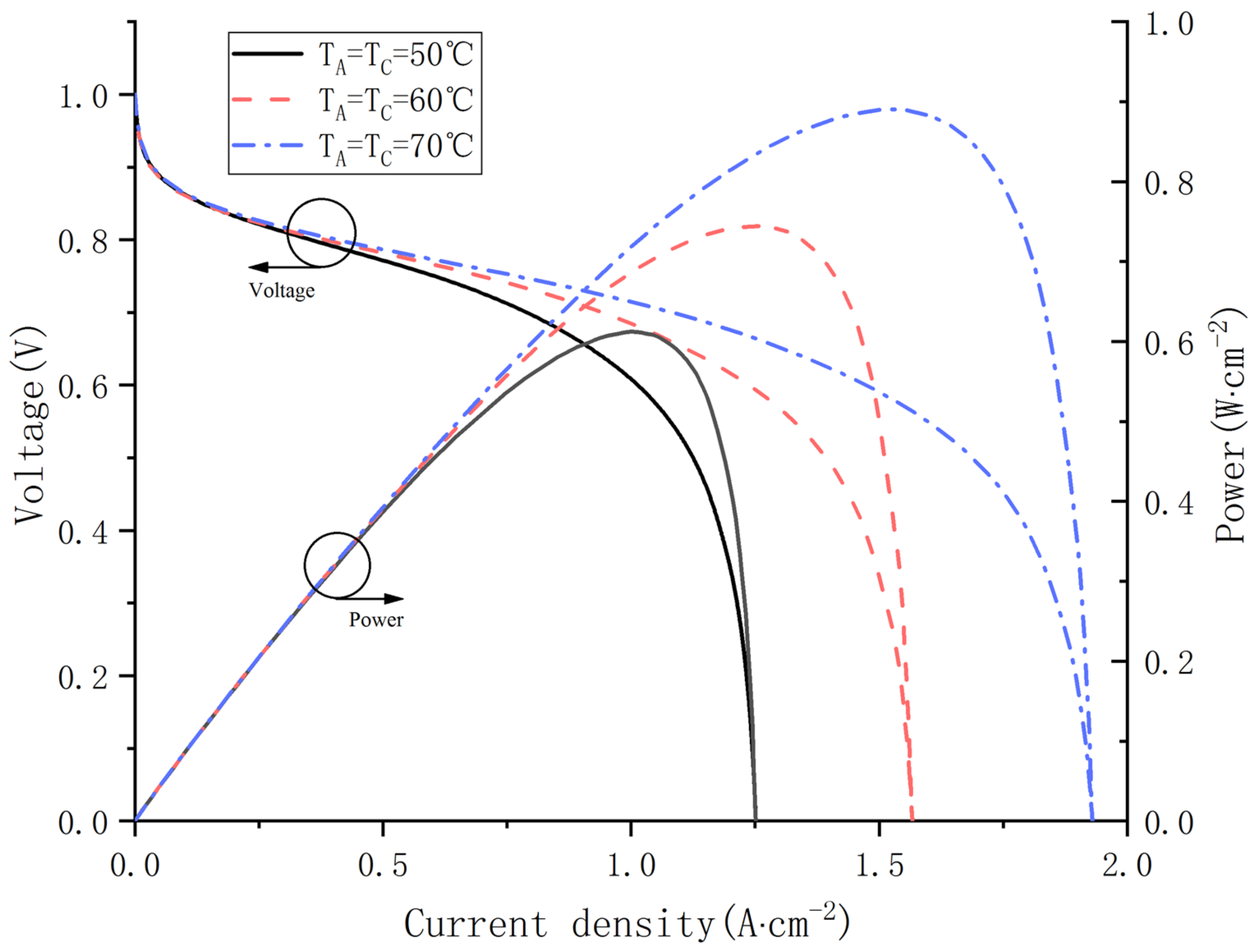
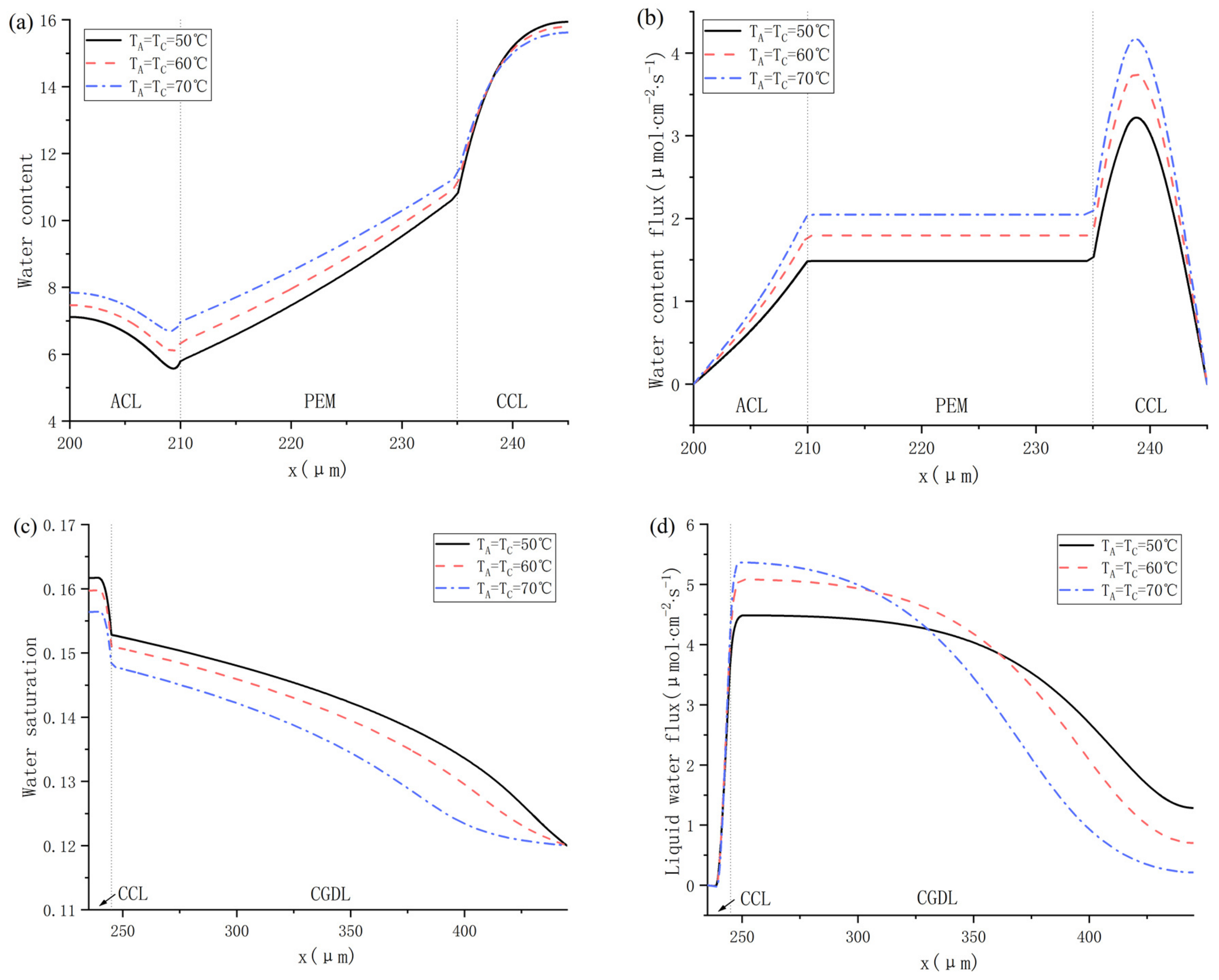
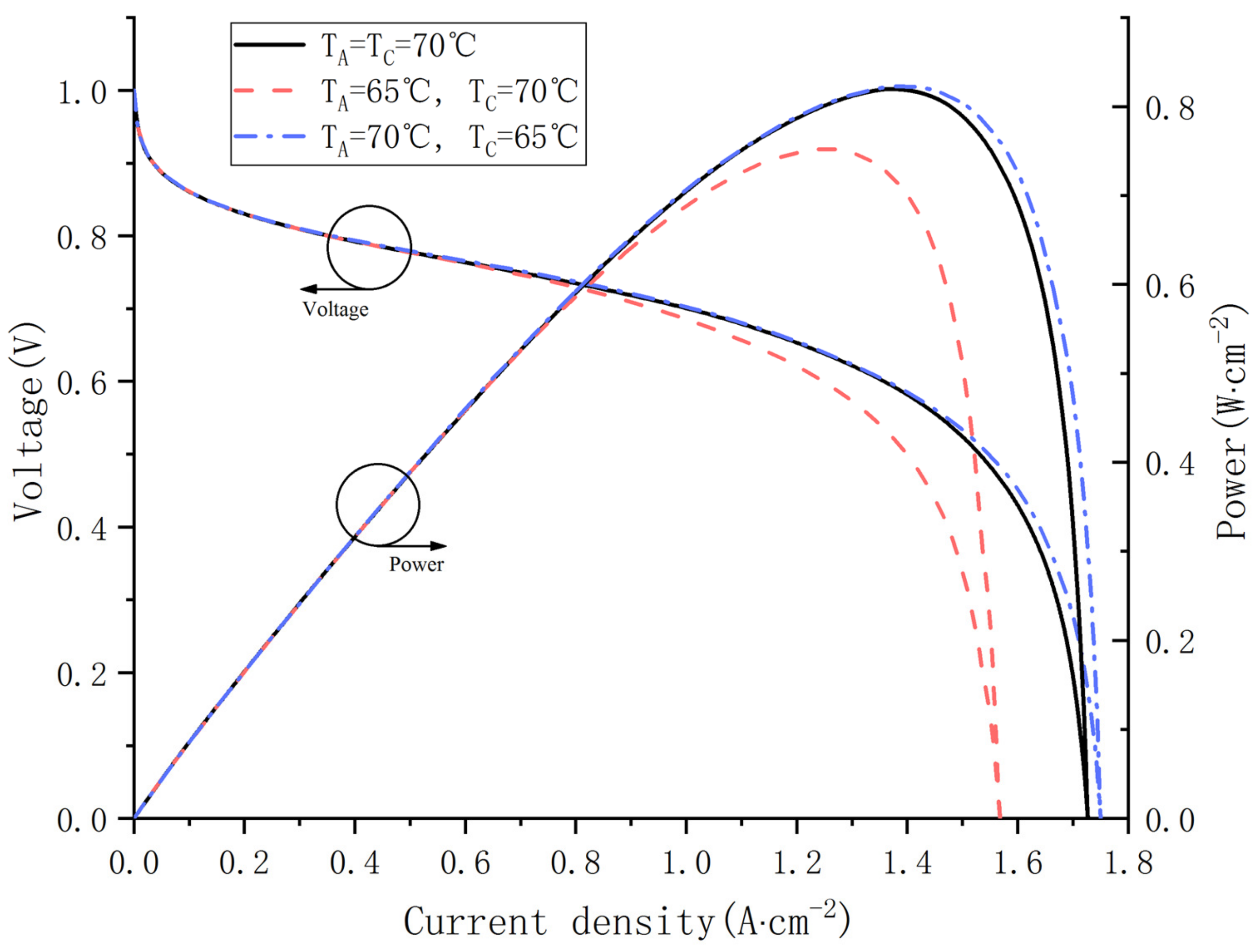

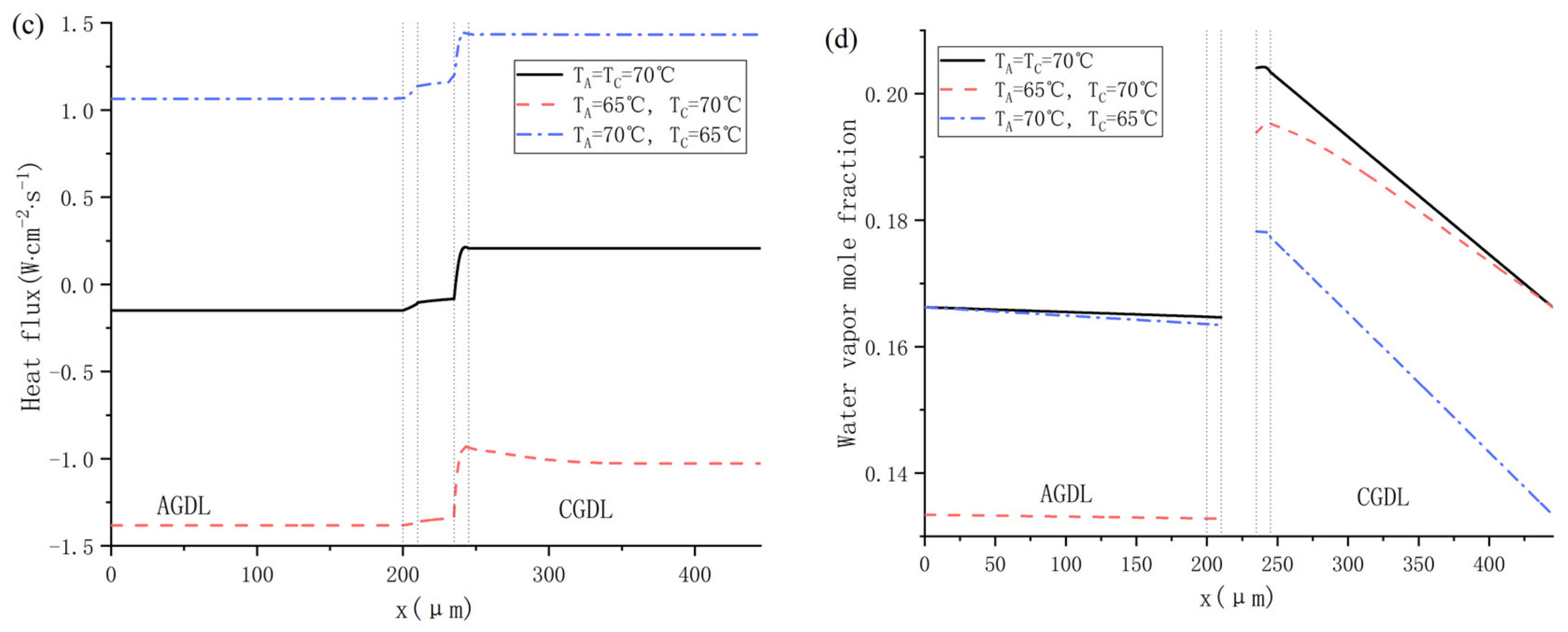
| Operating Conditions | Paper’s Experiment [33] | G20 Test |
|---|---|---|
| Anode/Cathode temperature (°C) | 80 | 80 |
| Anode inlet relative humidity | 100% | 100% |
| Cathode inlet relative humidity | 100% | 100% |
| Anode stoichiometric ratio | 3 | 1.5 |
| Cathode stoichiometric ratio | 3 | 2.5 |
| Anode/Cathode pressure (atm) | 1 | 2 |
| Parameters | PEM | ACL&CCL | AGDL&CGDL | Interface between CGDL&Channel |
|---|---|---|---|---|
| Thickness () | 25 | 10 | 200 | - |
| Porosity | - | 0.4 | 0. 6 | - |
| Polymer’s volume fraction | 1 | 0.3 | - | - |
| Thermal conductivity () | 0.3 | 0.25 | 1.6 | - |
| Electrical conductivity () | - | 350 | 1250 | - |
| Absolute permeability () | - | 10−13 | 6.5 × 10−12 | - |
| Pore tortuosity | - | 1.6 | 1.6 | - |
| Equivalent capillary radius (μm) | - | - | - | 40 |
| Effective contact angle (°) | - | - | - | 110 |
| Surface tension of water (N/m) | - | - | - | 0.117 |
| Case Number | Voltage (V) | Pressure (atm) | Temperature (°C) | Inlet Relative Humidity (%) | ||
|---|---|---|---|---|---|---|
| Anode | Cathode | Anode | Cathode | |||
| Basic | 0.75 | 1.5 | 70 | 70 | 90 | 90 |
| Cas.1 | 1.00 | 1.5 | 70 | 70 | 90 | 90 |
| Cas.2 | 0.90 | 1.5 | 70 | 70 | 90 | 90 |
| Cas.3 | 0.80 | 1.5 | 70 | 70 | 90 | 90 |
| Cas.4 | 0.70 | 1.5 | 70 | 70 | 90 | 90 |
| Cas.5 | 0.60 | 1.5 | 70 | 70 | 90 | 90 |
| Cas.6 | 0.50 | 1.5 | 70 | 70 | 90 | 90 |
| Cas.7 | 0.40 | 1.5 | 70 | 70 | 90 | 90 |
| Cas.8 | 0.75 | 1.5 | 70 | 70 | 90 | 10 |
| Cas.9 | 0.75 | 1.5 | 70 | 70 | 90 | 90 |
| Cas.10 | 0.75 | 1.5 | 70 | 70 | 10 | 90 |
| Cas.11 | 0.75 | 1.5 | 50 | 50 | 90 | 90 |
| Cas.12 | 0.75 | 1.5 | 60 | 60 | 90 | 90 |
| Cas.13 | 0.75 | 1.5 | 70 | 70 | 90 | 90 |
| Cas.14 | 0.75 | 1.5 | 70 | 70 | 80 | 80 |
| Cas.15 | 0.75 | 1.5 | 65 | 70 | 80 | 80 |
| Cas.16 | 0.75 | 1.5 | 70 | 65 | 80 | 80 |
Disclaimer/Publisher’s Note: The statements, opinions and data contained in all publications are solely those of the individual author(s) and contributor(s) and not of MDPI and/or the editor(s). MDPI and/or the editor(s) disclaim responsibility for any injury to people or property resulting from any ideas, methods, instructions or products referred to in the content. |
© 2023 by the authors. Licensee MDPI, Basel, Switzerland. This article is an open access article distributed under the terms and conditions of the Creative Commons Attribution (CC BY) license (https://creativecommons.org/licenses/by/4.0/).
Share and Cite
Gong, D.; Xu, S.; Gao, Y. Investigation of Water and Heat Transfer Mechanism in PEMFCs Based on a Two-Phase Non-Isothermal Model. Energies 2023, 16, 697. https://doi.org/10.3390/en16020697
Gong D, Xu S, Gao Y. Investigation of Water and Heat Transfer Mechanism in PEMFCs Based on a Two-Phase Non-Isothermal Model. Energies. 2023; 16(2):697. https://doi.org/10.3390/en16020697
Chicago/Turabian StyleGong, Dapeng, Sichuan Xu, and Yuan Gao. 2023. "Investigation of Water and Heat Transfer Mechanism in PEMFCs Based on a Two-Phase Non-Isothermal Model" Energies 16, no. 2: 697. https://doi.org/10.3390/en16020697
APA StyleGong, D., Xu, S., & Gao, Y. (2023). Investigation of Water and Heat Transfer Mechanism in PEMFCs Based on a Two-Phase Non-Isothermal Model. Energies, 16(2), 697. https://doi.org/10.3390/en16020697






